
The entire web playing field is about to change because of AI.
Are you ready or at least thinking about it?
A few stats:-
- Over four in five (81%) shoppers conduct online research before making a purchase. (Invoca, 2024)
- Nearly four in 10 (38%) would stop engaging with a website if the content or layout were unattractive. (Zippia, 2023)
- 57% of internet users say they won’t recommend a business with a website with a poor web design on mobile. (Forbes, 2024)
- 61% say they’ll go to another site if they don’t find what they’re looking for within five seconds. (Forbes, 2024)
- 86% of visitors want to see information about a company’s products and services on their homepage. (Ko Marketing, 2024)
- 15% of U.S. adults are “smartphone-only” internet users, meaning they don’t have a home broadband service. This number rises to a fifth (20%) for those aged 18 to 24, highlighting the importance of a mobile-friendly site. (Pew Research Center, 2024)
Despite these stats, more than one in four (27%) SMEs in the U.S. don’t have their own site. The statistics shown are general; however, websites are even more important in hospitality, where people dream of travel and are attracted by superb photography and video, excellent site design, tailored messaging, and a frictionless, trustworthy booking flow. OTAs increasingly dominate the booking space but struggle to elaborate at a hyperlocal level. Independent websites can offer a much richer experience but frequently do not reach the mark.
Add the mobile revolution, and traditional websites need a rethink for the future too:
The shift to mobile-first strategies is undeniable, with travellers increasingly relying on their smartphones to plan and book their trips:
- Mobile devices made up 70.5% of global online travel traffic in 2024, yet desktop devices still lead in conversion rates for actual bookings.
- Mobile wallet usage for travel bookings grew by 30% in 2024, making it a preferred payment method.
- Travel apps generated $629 billion in revenue in 2024, a 13% increase from the previous year.
- The mobile travel booking market is projected to grow from approximately $228.4 billion in 2024 to more than $526.4 billion by 2032, reflecting a compound annual growth rate (CAGR) of 11%.
The only reason to have a website is to be seen, to show your business, your brand, your hospitality. Yes its to attract direct business and showcase you to new owner prospects. However there is another reason and this is to focus on de-risking your business as suggested by the “declaration of independence below”.
In a world where the OTAs are claiming more digital real estate and often making more from portfolios monthly than the actual manager, the writing is on the wall. Check out these stats kindly supplied by Key Data Dashboard
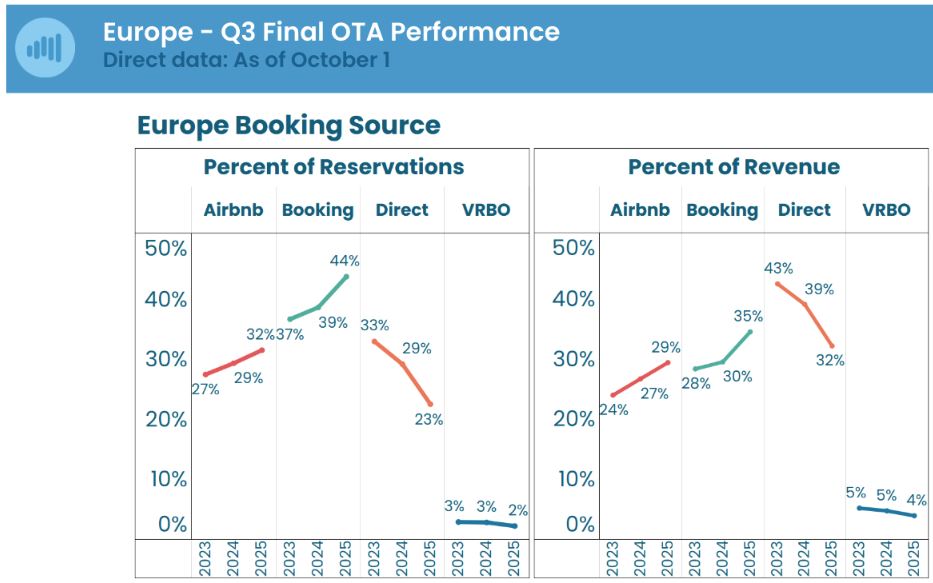
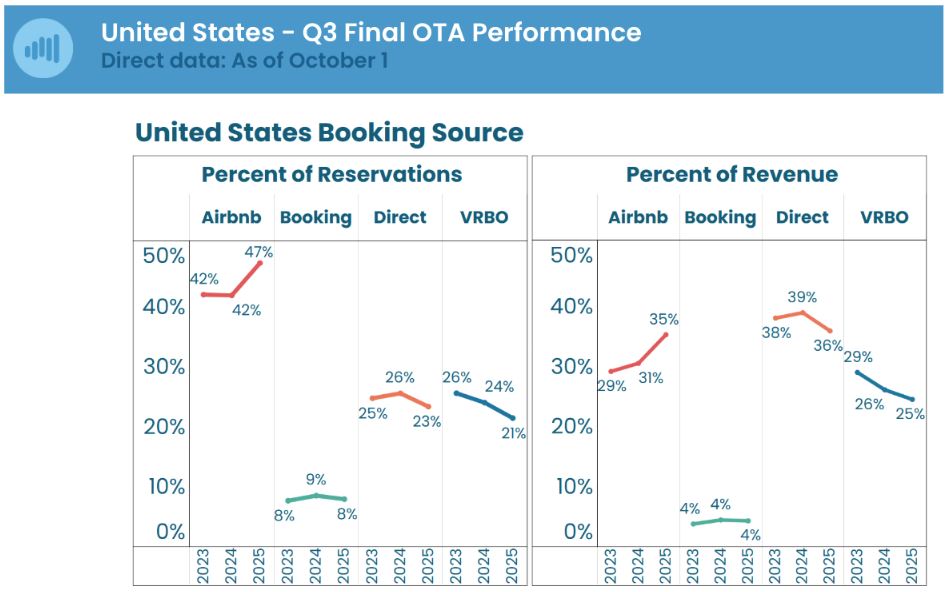
Europe: Percentage of direct reservations drop from 33% in 2023 to 23% in 2025. or 10% drop in three years on direct and an 11% drop in revenue.
USA: Percentage of direct reservations drop from 25% in 2024 to 23% in 2025 and a 3% drop in revenue but starting from a lower starting point tan Europe.
Websites are evolving and its time to act. The window is closing.
To kick off this report, here are a few words from one of our industry experts, Humphrey Bowles, on why new web development and designs, traffic generation and AI with feedback loops have become pivotal in the web armoury as OTAs increase their web dominance, evidenced by recent data publications by Key Data Dashboard.
Your website? That’s your declaration of independence.

Most hosts think direct websites are about ‘getting more bookings.’ They’re missing the bigger picture. Book direct isn’t just marketing, it’s your escape route from digital sharecropping and platform exploitation. When you only accept guests from Airbnb or Booking.com, you’re building their business with your property. They own the customer data. They control the relationship. They set the rules.
Your website? That’s your declaration of independence. But let’s be honest, when you’re competing with OTAs (and you are competing), it can’t be done with some glorified brochure built on outdated WordPress that converts like it’s 2010.
The future belongs to AI-enhanced websites that match what OTAs offer, and booking engines that don’t just capture leads but build scalable businesses you actually own. Complete operations that provide, for example, the full trust stack guest screening, protection, and claims management. The reality is, OTAs convinced us that convenience equals success. Real entrepreneurs know that dependency equals a slow, lingering death by a thousand policy updates.
Today’s technology means convenience no longer requires surrendering control. You can have both a seamless guest experience with proper screening and protection, AND own your business. Because when platforms decide they don’t want your business anymore, and they will, your website is the only thing standing between entrepreneurship and unemployment.
Humphrey Bowles (Truvi) – Build the asset. Own the relationship. Control your future.
WEBSITE HISTORY
It all started somewhere, and with billions of webpages available, it may be good to understand the avalanche of online information and shop windows. The first website went live at CERN in 1991, and its immediate use was almost exclusively focused on academic or government activity (think military, no doubt).
The dot-com boom of 1995 to 1999 saw the launch of “Netscape Navigator,” and anyone with a computer could start browsing the internet. By the late 90s, large corporations were investing heavily in their own websites.
After the dot-com crash of 2000, the few survivors focused on commercial opportunities such as e-commerce, booking of all manner of things, news distribution, and, of course, “search”. This was accelerated by the adoption of broadband and the fast demise of dial-up! This allowed for much richer content and quicker delivery, both upstream and downstream.
For all of those who remember dial-up, get nostalgic below and listen!
SMEs began adopting websites thanks to cheaper hosting & DIY tools (think WordPress), and so by the mid-2000s, customers increasingly expected even small companies to have a website.
As websites became mainstream and an essential part of any business, Web 2.0 emerged and was generally recognised for its dynamic content and transactional capabilities, even if it was just for sending emails. There were plenty of tools for budding web designers and developers, such as Dreamweaver (Macromedia 1997) and Microsoft FrontPage, to assist in the development of business and personal websites. Then mobile exploded from 2008 onward and has become the dominant website search tool for many industries.
In reality, websites are no longer optional, unless, as Airbnb would argue, you work exclusively through their platform. For professional managers and active hosts, this is very high risk and long-term expensive.
Guest and consumer expectations have evolved accordingly, with instant responses, online payments, immediate communication, and woe betide any who fail to meet these expectations. Not only this, but the delivery must be fast, mobile-friendly and transactional.
From the supply’s perspective, smart websites are becoming increasingly important, as they analyse guest interaction in real time and AI begins to facilitate increased conversions.
THE WEB TODAY
In short-term rentals, how did we get to where we are today? What does the ecosystem look like, and how has it evolved since 2012?
Businesses increasingly needed dynamic content such as blogs, news, e-commerce and hence, CMS platforms emerged and were widely adopted. There are many, and we have given a snapshot below of several well-known ones and the number of websites:

- Drupal launched around 2001, and was strong in developer communities
- Joomla followed later, around 2005. It was definitely easier than Drupal and popular with small businesses
- WordPress, the Gorilla of today, came into being around 2003 and has evolved into the dominant CMS.

33 million (2000) 435,000 (2001) 830,000 (2003)
CMS systems are generally designed to accommodate multi-category business models. WordPress, the dominant system, offers 60,000 plugins and templates, many of which cater to industries but lack true specialist systems, especially for very challenging markets with multiple specialities.
These systems can also come with problems that are often solved by developers and CMS use experts, but not by the average consumer. Hosting, DNS records, email setups, plugin conflicts, security, search challenges and more are all familiar ground.
This “open source” approach led to companies such as Wix and Squarespace, which cater for these problems and remove the risks. As you can see, Wix has a substantial number of sites, but not all are paying, and not all are under dedicated domains.

529,000 (2004) 48,000 (2003/4) 8.1m (2011)
Why did WordPress become dominant where others did not?
WordPress: From its inception, WordPress was a blogging platform. It emphasised ease of use, with a simple dashboard and “posts and pages” structure. This made it relatively accessible to individuals and small businesses who wanted to create a website without any coding knowledge. Its PHP architecture and open source approach lend themselves to a broader range of developers and web build companies.
Joomla: Joomla was designed as a middle-ground CMS. It’s more powerful than WordPress, with more complex content structures and user access controls, but this came at the cost of a steeper learning curve.
Drupal: Drupal was built from the ground up as a strong framework for developers. It offers flexibility, security, and scalability, making it a better choice for complex and often high-traffic websites. However, this requires significantly more technical expertise to set up and manage, putting it out of reach for most users.
The very reason WordPress became popular is the same reason commercial platforms are now challenging it, and as we can see, WordPress is tapering off on the growth curve. It’s still an open-source, economical way to self-build a website. If you want a simple, basic content delivery strategy that doesn’t consider LLM and Google EAT listing architecture, it works. Delivering traffic and conversions of bookings and enquiries is another question, covered below.
Despite the full platform support, online help, and more, there are considerable challenges in creating great designs, ensuring all elements work in unison, and for STRs, converting and drawing traffic. Thousands of contractors specialise in modifying these systems. But many have no explicit STR expertise!
The web builder market continues to see significant investments
Read the Framer web narrative below, one of the latest incarnations, which was early profitable, paving the way for the next Series D $100m investment. Ask why this is the case?
Quote: Framer is becoming the standard for professional sites. Framer helps companies build and run better websites, better looking and better working, without code. Designers and marketers can now ship an entire.com directly, making Framer the fastest way to build and scale large, high-quality sites. That shift is already happening. Close to half of the latest Y Combinator batch launched with Framer, alongside global brands like Perplexity, Scale AI, Huel, Miro, Zapier, and Mixpanel. Today, hundreds of thousands of sites run on Framer, with more than half a million people using the platform each month.
For more than a decade, tools like Wix and Squarespace have made it easier to spin up personal sites. But when it comes to professional, high-traffic, brand-defining websites, teams have still been stuck in developer-heavy workflows. That’s the gap we’re closing.
(Editor: Our research indicates you still need to be a developer, not a consumer hobbyist, to make the most of Framer!)
Why the big investments?
Simply because it’s a big market and increasingly in flux as e-commerce and marketing focus are driving increasingly sophisticated website needs.
The global Website Builder Software Market was valued at approximately USD 2.1 billion in 2024. It is expected to rise to USD 2.25 billion in 2025 and eventually reach USD 3.89 billion by 2033, expanding at a CAGR of 7.1% from 2025 to 2033. Source:
The average cost of designing a small business website is between $2,000 and $9,000. (Forbes, 2024). On top of this, the average annual maintenance fee totalled $1,200.
In 2024, a simple website can cost as little as $16 per month, whereas a more complex site requiring expert assistance can cost over $10,000. (Wix, 2024). The global website builder industry is projected to be worth $2.1 billion in 2024 — an 11% rise from 2022. (MarketResearch, 2023)
For corporate websites with up to 75 pages, these costs rise fourfold to between $10,000 and $35,000. At the same time, the average maintenance costs for running a corporate site are $15,000—over 10 times more than the typical amount for a small business website.
Website building is still too complex for the average user
The Realities of Website Development with Open CMS Platforms
Despite the proliferation of website-building tools, creating a professional, high-performing website remains a complex undertaking for most individuals. Subscribing to Wix or other commercial software, purchasing WordPress hosting, or installing a pre-made template may appear straightforward. Still, the reality quickly expands into an array of administrative, design, and technical tasks: image optimisation, plugin management, content structuring, and ongoing maintenance.
Why WordPress Feels Complicated
WordPress is an open-source, “self-hosted” content management system. This provides unmatched flexibility, but it also shifts responsibility onto the user. You must:
- Install the software on your hosting account or deploy via the cloud instructions
- Secure and update the platform regularly
- Troubleshoot conflicts and maintain performance
Some hosting providers offer management tools, but the accountability for stability and security rests with the website owner. This is a stark contrast to SaaS platforms like Wix or Squarespace, where hosting, updates, and software maintenance are centrally managed. The trade-off: while SaaS platforms reduce operational overhead, they limit ownership and control of the site.
The Challenge of Choice
The WordPress ecosystem offers more than 60,000 plugins and 10,000 themes. This abundance creates a paradox of choice: newcomers often struggle to identify the right tools for their needs. Because diverse third-party developers build plugins and themes, they vary in interface design, quality, and functionality, and may even conflict with one another. There are also security issues. Resolving these typically requires additional technical knowledge or developer support.
Customisation and Design Complexity
While drag-and-drop builders simplify visual design, WordPress’s true strength lies in its modular building blocks, text areas, galleries, forms, and menus, which can all be arranged and customised. But customisation at a professional standard frequently demands knowledge of design principles and sometimes direct coding in CSS or HTML/PHP. Without this expertise, websites often feel generic, cluttered, or inconsistent with brand identity.
Knowledge Gaps: Hosting, Domains, and Content
Key technical concepts such as web hosting, domain management, and server reliability remain unfamiliar to many business owners. Even within the CMS itself, users often struggle with:
- Structuring menus and navigation.
- Organising and tagging content for clarity and SEO.
- Optimising images and assets to avoid poor load times.
These gaps highlight that the challenge is less about access to digital tools and more about the knowledge divide that prevents small business owners from turning basic digital literacy into a competitive business asset.
Business Impact of Poor Websites
A poorly executed website is more than an inconvenience; it’s a liability. Common outcomes include:
- High bounce rates are caused by slow performance or weak design.
- Brand erosion from unprofessional layouts or inconsistent experiences.
- Scalability issues occur when the site cannot evolve with business growth.
In contrast, investing in a professional, well-designed website can dramatically improve visitor retention, lead conversion, and brand perception. In many cases, a website is the first touchpoint between a business and its potential customers—making design not just an art form, but a measurable science that directly influences commercial outcomes.
STR Needs Specialist Websites
This is where the whole challenge begins, as STR businesses vary so much in operation, booking policies, pricing mechanisms, communication channels, photographic quality, shape and size, and most of all, the actual framework appearance and design! Plus, everyone has an opinion!
“All opinions are not equal. Some are a very great deal more robust, sophisticated and well supported in logic and argument than others.”
― Douglas Adams, The Salmon of Doubt: Hitchhiking the Galaxy One Last Time
Visual Design Study Proves It’s Very Important.
The results of this study indicated that website design is an essential factor in establishing trust in e-commerce. The results further revealed that website information design is more important to males than to females in forming e-trust. In contrast, website navigation design is more important to females than to males. However, website visual design was found to be a key driver of e-trust for both males and females.
There are hundreds of websites offering basic information on how to improve and design a website. This is one example.
WordPress (Love or Loath)
While the widespread use of platforms like WordPress offers a seemingly quick and affordable entry point, it presents significant risks and increasing disadvantages. Before we dive deeper into the WordPress environment, this “new” web company CEO offers an opinion:

The hospitality industry has been stuck using tools that were fundamentally mismatched for our needs from the start—WordPress was never originally designed for commerce, let alone the complex booking flows and real-time availability that vacation rentals require. Yet property managers with sophisticated operations are still building sites with these generic tools.
The fundamental problem is that most operators approach website development with a ‘done state’ mindset—they build a site, launch it, and consider the project complete. But in today’s market, there is no done state. Consumer behavior is shifting constantly: guests are increasingly using AI to discover stays, mobile booking has become the norm, and search patterns are being reshaped by conversational interfaces and voice search.
This creates a widening gap where legacy WordPress sites, held together with plugins and built as one-time projects, simply can’t adapt to these rapid changes. Every site built this way becomes frozen in time—what worked for SEO or conversion in 2020 may be completely wrong for 2025, but there’s no mechanism to evolve hundreds of individual sites simultaneously.
The industry needs platform thinking, not project thinking. At CraftedStays, instead of rebuilding the same site over and over again, we’ve built a platform that deeply integrates with property management systems to create purpose-built direct booking websites that can adapt and improve across an entire ecosystem of properties as guest behavior and search technology continue to evolve. We’re constantly testing booking flows, optimizing conversion paths, and adapting to new search behaviors—all without property managers needing to learn sophisticated systems or keep web developers on retainer. We built the Shopify for hospitality.
The hospitality industry is entering an era of unprecedented change, and the current infrastructure that most hospitality websites are built on simply isn’t prepared for what’s ahead—this is why at CraftedStays, we’re reimagining what booking websites should be in an AI-first world.
Design Fatigue
With over 40% of websites worldwide using WordPress (29% in the top 1m), it’s important to note that, regardless of consumer knowledge, websites are template-based and essentially modified versions of existing commercial ones. Template Monster offers over 6,000 templates, while the industry reportedly has as many as 30,000. Of these, some will be much more popular than others and will be segmented by target market.
Probably 30% (the best ones) are used for 75% of the websites. Still, as a direct correlation across 30 million WordPress websites, you are likely to see 1,000 of the same. If this is a very specialised territory, the likelihood is that you will see many websites looking very similar in layout and approach. A photo may change, a menu item might look different, the font may be slightly greyer and Arial instead of Calibri, but generally, it’s not really unique. The overall Website design often lacks the psychological drivers necessary to drive business. This also applies to PMS-based template websites, which can charge considerable sums for tweaking your website, too.
This Google Research document is fascinating and explains humans’ capacity for habituation and boredom. It’s well worth a read and quoted as:
“The debate between “boring” and “creative” is a false dichotomy. The future of web design belongs to those who can master this delicate, dynamic equilibrium—creating experiences that are both functionally effortless and emotionally unforgettable.”
Ask yourself why Booking.com and Airbnb do not look like a standard modified template WordPress site.
The WordPress Dilemma: Performance, Security & API Integration
A vast number of web developers utilise WordPress as the front end for short-term rental websites, often integrating it with APIs for dynamic listings. This approach, while popular, is a significant topic of debate.
The “Shortcut” Fallacy: Many developers see WordPress as a shortcut due to its vast ecosystem of themes and plugins, which can be modified to create a front end relatively quickly. However, this convenience often comes at the cost of performance, security, and long-term scalability.
Performance Concerns: WordPress is built on PHP, which can be less performant than modern JavaScript frameworks. A significant issue is “plugin bloat,” where the sheer number of plugins and themes slows down the website. For a transactional platform where speed is a key driver of conversion, this can be detrimental. In the competitive “Look to Book” flow, a slow-loading page can cause a guest to abandon their search.
Questionable Security: WordPress’s open-source nature and popularity make it a prime target for cyberattacks. The most common security vulnerabilities come from outdated or poorly coded third-party plugins and themes. For a website handling sensitive guest data and financial transactions, relying on a system with a documented history of security issues is a significant risk. Securing a WordPress site requires constant vigilance and maintenance. “Wordfence”, a security plugin, apparently blocks 330 million hits every day.

API Integration & Development Capacity: While it is possible to integrate WordPress with APIs, the process is often clunky. The PHP-based development capacity of WordPress is not natively optimised for the real-time, dynamic data flows required by API connectivity to PMS systems. This can lead to custom development that is more complex and less efficient than a modern stack, negating the “shortcut” benefit.
The Architectural Solution: A Multi-Layered Approach: To overcome the limitations of platforms like WordPress, a modern, modular architecture is the most advantageous approach.
Back-End: API-First & PMS Integration: The core of your website must be built to handle dynamic data from various sources.
Front-End: Modern Frameworks & Headless CMS: The front end should be built for speed and responsiveness.
Headless CMS: A headless CMS separates the front end (what the user sees) from the back end (the data). This allows you to use a lightweight, high-performance front-end framework like React or Vue to consume content and data via APIs. This results in a faster, more secure, and more flexible user experience.
Code Base: The most advantageous code bases are those built on modern JavaScript stacks like MERN (MongoDB, Express, React, Node.js) or MEAN (MongoDB, Express, Angular, Node.js). These are optimised for building high-performance, real-time applications and are ideal for the high volume of transactions and dynamic data required by a rental website.
Advanced Features: AI & Analytics: To compete in this increasingly specialised industry, you must incorporate advanced technologies.
AI for Search: AI can transform the search experience by moving beyond simple filters to understand natural language queries (e.g., “I’m looking for a pet-friendly apartment with a balcony in London.”). AI can also personalise recommendations based on past user behaviour and preferences.
Data Analysis: Implement a robust analytics system from day one. This will allow you to analyse guest behaviour, track conversions, and identify areas for optimisation within the Look to Book flow. This data-driven approach is critical for improving traffic and increasing bookings.
To understand how AI will change the web dynamics, the following are a few lines from the CEO of flataway.ai

“AI will fundamentally change how we interact with software, moving the user experience beyond the browser into new interfaces, possibly new devices too, powered by chat, voice, and agents. In that world, traditional websites may become obsolete. But what happens in the meantime?
We’ve already witnessed several waves of change in how vacation rentals are booked – from postcards to fax machines, emails, and finally templated booking sites. In each case, the old method was replaced when the new one became universally accessible, affordable, and easy to implement. We’ve now reached that point with vacation rental websites.
Custom direct booking sites with API integrations to the PMS used to cost tens of thousands, pushing most managers toward WordPress – a blogging platform retrofitted with predefined themes and plugins, often clunky and unreliable, always due for an update. We are now witnessing the long overdue sunset of WordPress.
Today, tools like Lovable – the fastest-growing tech product ever – let anyone build stunning, unique websites using natural language, in minutes, for a few bucks. These tools are powerful but generic, lacking the deep vertical knowledge needed for industry-specific or complex use cases. That’s why we are now seeing the rise of specialized AI website builders, equipped with seamless integrations to the tools used by the customer and built by people with vast industry expertise. The next frontier ahead of Flataway is making vacation rentals bookable through AI agents directly and preparing for a future where travel bookings happen through voice, chat, and new interfaces we can’t fully imagine yet, but are already preparing for.
Boris Pavlov, CEO Flataway.ai
DIRECT BOOKINGS
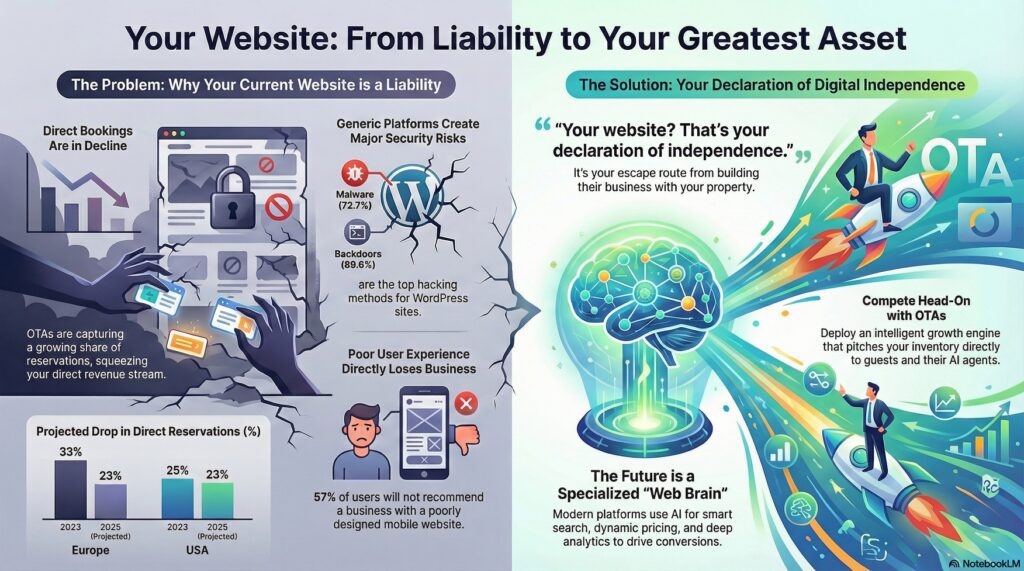
The Holy Grail of a manager’s life. Imagine not bowing down to the OTA Gods. Imagine 100% of your bookings coming through your own website. There are many companies, admittedly in the leisure industry, that see 100% direct bookings and do not even list on an OTA. The majority, however, do use OTAs, and these powerhouses have armies of experts to market and convert under their global brands.
Managers and even owners need to think like an OTA but act like their own micro, hospitality-focused brands. All have advantages in price, communication, or personal service. OTAs cannot defend this on such a scale.
It is well known that look-to-book conversions across both hotel and STR websites in general show a very poor conversion ratio. Hotel conversions hover around 1% and vary by group brands, and circa 3% at the checkout page. We see stats at <0.25% on STR websites, and the good ones are converting close to hotel figures.
It is hard enough to get traffic, but there are rules for achieving this, not just for this article, but also for covering standard SEO and LLM focus (GEO or Generative Engine Optimisation). EAT (Authority, Expertise & Trust for content) site flow and process, signals and payments, all helping develop a company brand, and all leading to trust and action by a guest. All need consideration when designing your website, especially as the website game and app approach reaches new dimensions!
This new generation is like comparing Web 1 to Web 2 and black and white cine reels to AI-generated box office films.
Mapping:
Google has been the dominant mapping tool on websites, a pin is generally the only thing seen to show where a property is located. Variations on sophistication and danger of leakage back to Google search where your competitors can advertise the paid and other organic positions, conveniently knowing where your guest is searching. Yes there are alternative such as OpenStreetMap (OSM) but will little benefit except leakage and option to use tools such as Mapbox as an overlay on OSM which can offer a more elegant approach, but the map does little else.
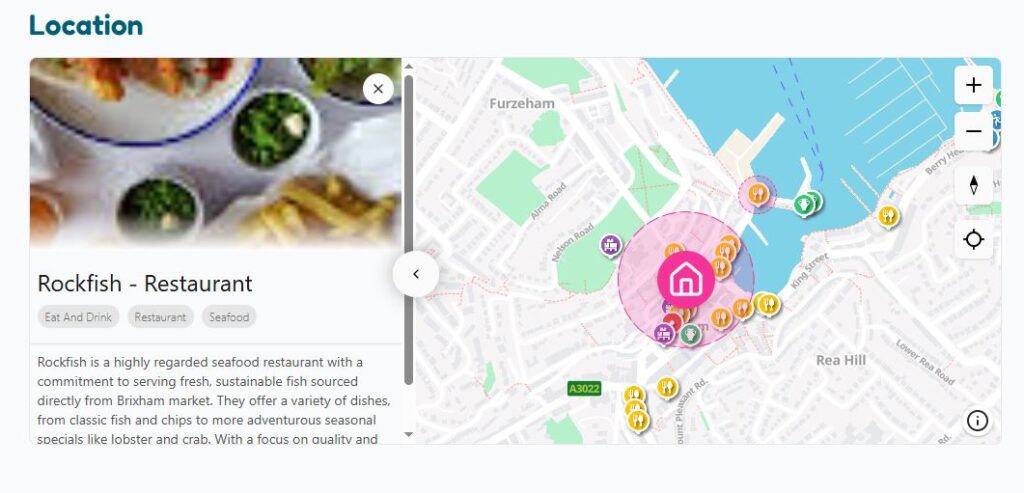
The map can be a selling tool as shown by Geovey, a UK company now offering maps that sell and inform. This is a quote from one of the founders, Dave Barter, a founder of Geovey.ai
“Maps sell the story of a place. Guests don’t read — they scan. A great map brings local knowledge to life, helping visitors book with confidence. Put the map front and centre, not hidden away. A poor map creates doubt — and doubt sends guests straight to Google.”
Democratising Websites
The following are a few lines from a new web platform CEO of HostAi, who gives a flavour of where it’s all going for the subsequent web developments

Solving direct bookings is like opening a combination lock: you need to nail reach, persuasion, and pricing simultaneously to get real results. Until now, custom-built or templated websites have been like brochures; they were too passive to get the whole job done. That’s why the challenge of growing direct bookings has remained unsolved for most short-term rental brands. The good news is that the entire playing field is about to change because of AI. We see two significant tailwinds transforming direct bookings: (1) AI agents will own travel discovery and planning for guests, which erodes the dominance of OTAs; (2) Language models have democratized access to AI, and we’re able to deploy them to solve the combo lock and compete with OTAs head-on, in a way that wasn’t possible before.
Today’s travellers expect intelligent experiences that anticipate their needs. We’ve seen personalised pricing alone double conversion rates for customers, but pricing is just one piece. The next frontier is programmatic generative engine optimisation (GEO), where your properties are automatically discovered in AI-powered conversations and travel planning tools. Growing direct bookings isn’t about having a website anymore; it’s about deploying an intelligent growth engine that pitches your inventory to your ideal guest profile and their AI agents.
Amirali Mohajer, Founder Hostai
AI RESEARCH ADVICE
Asking Google/Gemini and ChatGPT about which is the best web tool or code base to use demonstrates the challenge. Online document history and self-interest commercial promotion clearly polarise the advice on what systems to use, and caution is advised. Expert knowledge or at least exhaustive research is required before adopting any approach.
This approach also highlights the need for GEO in the evolution of your website’s content and structure, as LLMs have absorbed endless advice from web developers, PMS companies, SEO experts, and hosting companies, all of which sell the benefits of WordPress as it’s the foundation of their business!
So, which website system to use for your STR website?
2000-2025 – is History
WordPress is not going away overnight, and it is adequate for small businesses, especially those that are OTA-dependent and those that want to see a % of re-bookings from previous guests, but even this is not guaranteed. This ageing CMS, with its thousands of plugins, look-alike designs, and security issues, is being challenged by the new breed of CMS and web build systems, highlighting the difficulty of creating trustworthy, frictionless sites.
Yes, many WP websites have significant search positions and transaction success. Still, in our experience, the vast majority underperform due to a combination of site design, flow, lack of background work on links, content, and general SEO, exposing trust issues. Build and leave is not a formula for success.
Constant evolution is necessary, and professionals need to ensure their websites are built on modern approaches that scale, seamlessly cross platforms and browsers, are secure and fast, have enhanced data connectivity and improved information access, support AI foundational advice, and feature fluid, unique designs.
2026 – The Future – Where it’s going
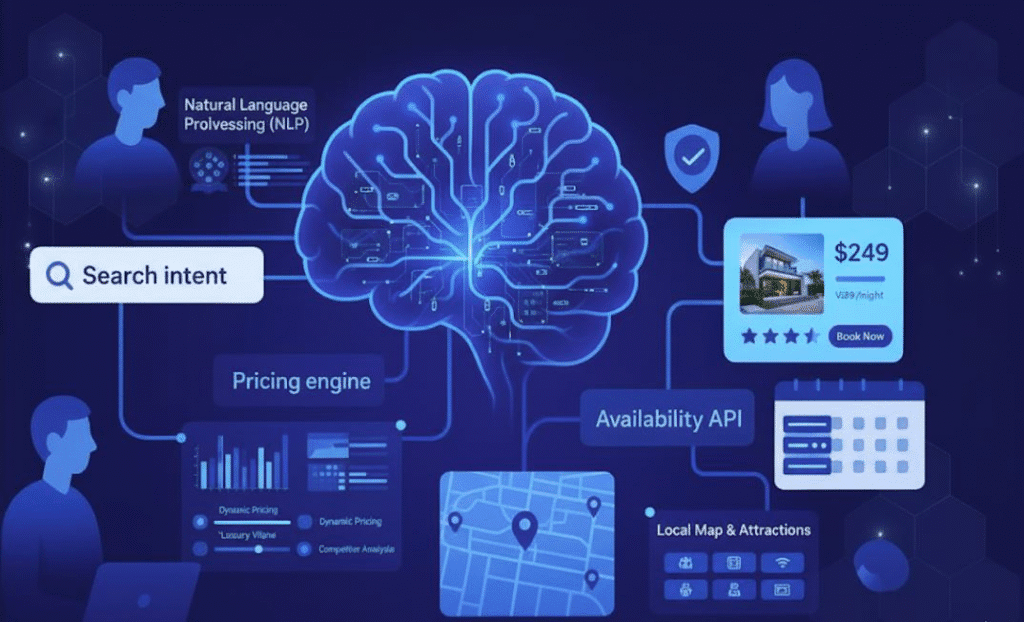
We see AI assisting web development by incorporating a “web brain” and playing an interactive role with guest traffic, while keeping performance at its peak and enhancing and creating a unique style brand for you.
With the trend to adopt compound PMS systems from one of the big suppliers, API access is still required, and care needs to be taken regarding the API quality and structure, the available data, and, of course, the price (which we would hope is part of the subscription price and no more).
However, consider a future where your web tracks traffic, decides which deals should be offered, compares OTA deals, negotiates if necessary based on guests’ and owners’ needs, uses internal business intelligence on performance, makes the booking, and manages all follow-ups. We are very close to this reality, but it does require more bespoke, tailored and non-legacy systems. This is an inflexion moment for websites.

More reading on Yes.Consulting™:
[WORDPRESS_PDF]
